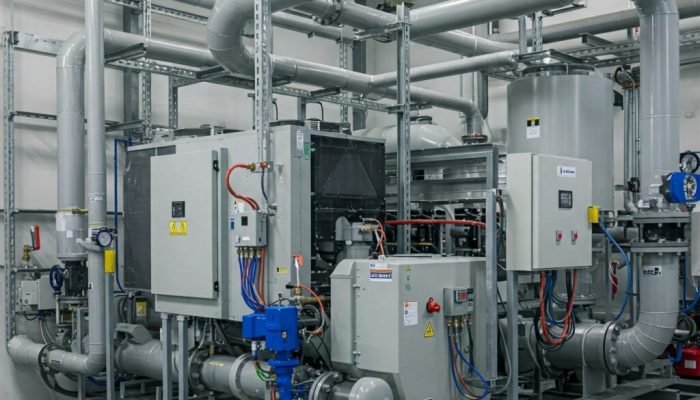
Implementing Industrial Heat Pumps for Net-Zero Decarbonisation
As industries transition toward net-zero emissions, large-scale industrial heat pumps have emerged as a pivotal decarbonisation technology. Heating processes account for over 70% of energy demand in industrial sectors, and much of this is still met by fossil fuels. By electrifying heat supply and recovering low-grade waste heat, industrial heat pumps drastically reduce Scope 1 and Scope 2 emissions while improving energy efficiency.
These systems are no longer niche — they are rapidly being adopted across textile, food, chemical, pulp and paper, and pharmaceutical industries for their ability to deliver high-efficiency, low-carbon heat at useful process temperatures.
How Industrial Heat Pumps Work in Industry
Industrial heat pumps operate on the principle of transferring heat from a low-temperature source (e.g., wastewater, ambient air, flue gases) to a higher-temperature process. Powered by electricity — ideally from renewable sources — these systems replace or complement traditional boilers by supplying temperatures between 70°C and 150°C, depending on the technology.
For instance, in the food processing sector, heat pumps can reclaim heat from refrigeration systems and use it to preheat cleaning water or pasteurize products. In textile manufacturing, exhaust air from dyeing operations can be recovered and re-used, displacing fossil fuel-based heat entirely.
Best Practices for Implementation
1. Conduct Detailed Heat Mapping
Start by identifying where heat is used and wasted within the facility. Evaluate temperature levels, load profiles, and variability in demand. This helps determine which processes are suitable for integration with a heat pump.
2. Choose the Right Heat Pump Technology
-
Vapor Compression systems are suited for mid-temperature applications.
-
Absorption Heat Pumps use thermal energy as the driving force and can be ideal where waste heat is already available.
-
High-temperature Heat Pumps (up to 125°C) are emerging and suitable for more demanding industrial applications.
3. Assess the Source of Waste Heat
Common sources include:
-
Boiler flue gases
-
Compressor discharge
-
Chilled water return lines
-
Wastewater from cleaning processes
Matching source and sink temperatures is key to achieving high COP (Coefficient of Performance) values — often between 3 and 6, meaning 3–6 units of heat per unit of electricity.
4. Integrate with On-Site Renewables
Linking heat pumps with solar PV or wind power significantly enhances emissions reduction. This also contributes to resilience and energy independence.
5. Incorporate Thermal Energy Storage
Thermal storage, such as hot water tanks or phase change materials, enables load shifting, reduces peak electricity usage, and ensures a continuous heat supply even when demand fluctuates.
Real-World Applications for Energy Savings
Dairy Industry (EU): Heat pumps are widely used to preheat cleaning-in-place (CIP) systems using waste heat from chillers and compressors.
Breweries (UK): Many breweries recover heat from wort cooling processes and reuse it for mashing and space heating.
Textile Plants (Asia): Industrial heat pumps recover steam condensate and reuse heat in dye baths, cutting natural gas consumption by up to 40%.
These examples demonstrate that industrial heat pumps are financially and technically viable, especially when combined with detailed energy analysis, system integration, and long-term monitoring.
From Audit to Execution — DecarbSol’s End-to-End Approach
-
Identify energy-saving and emissions-reduction potential through detailed energy audits
-
Develop techno-economic feasibility studies tailored to each industry
-
Engineer front-end designs with optimal system configuration
-
Oversee or execute turnkey implementation
-
Apply internationally recognized M&V protocols (like IPMVP) to ensure savings are real, verifiable, and aligned with climate goals
This approach eliminates greenwashing and delivers real CO₂ savings with traceable impact — ensuring your transition to net-zero is both credible and cost-effective.
Industrial heat pumps are not only a sustainable heating solution — they are a strategic investment toward operational efficiency, energy cost reduction, and climate responsibility. When properly integrated, they offer strong ROI and a measurable contribution to net-zero targets. Whether you operate one site or manage a global supply chain, heat pumps can be scaled to support long-term low-carbon operations.
